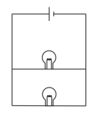Circuits
Lighting a Lamp
| Students will be able to test a variety of electrical pathways using direct current circuits and demonstrate that electricity can be transformed into light, heat and sound |
Preamble
I use no introductory activity or discussion about electricity and when we use it or what life would be like without it. My students have so much fun just making the lamps light up and getting a buzzer to sound that this alone has completely captured their interest in the unit.
The class should be put in groups of three or four students.
Equipment
Each group is given:
- 2 flashlight bulbs
- 8 wires with crocodile clips
- 1 D battery in a holder
- a buzzer (optional)
Challenge 1
- Can you make one lamp light up?
- Can you make the buzzer sound? (optional)
- Can you make two lamps light up?
- Can you make two lamps light up by connecting them in three different ways?
Draw a picture to show your solution to each of these challenges.
Teacher: Move around all the groups and admire their work, and encourage them to try for three different circuits to light two lamps. If they really cannot get one lamp to light, they will need assistance. However, do not offer assistance for the two lamps, but point out when two of their solutions are actually the same. Some groups may come up with more than three different circuits, which should be congratulated (even though the circuits can be rather strange).
- The pictures they drew should now be changed into diagrams. Demonstrate to the students the conventions for drawing electrical circuits.
- Ask students to share how they connected the circuit to get two lamps to light. In general they will have a simple series circuit, two simple series circuits both connected to the one battery and, maybe, a parallel circuit. Accept their answers without too much comment.
- Introduce the term "circuit".
Challenge 2
For this challenge, only circuits in which one, and only one, wire is connected to each end of the battery, are allowed.
- Can you make a circuit in which two lamps are lit and then, by disconnecting the circuit in just one place, both lamps turn off?
- Can you make a circuit in which two lamps are lit and then, by disconnecting the circuit in just one place, only one lamp goes out?
- Is there another place in the previous circuit, which if you disconnect it, the other lamp goes out?
Teacher: Move around all the groups and listen in to the discussion. Try not to allow them to talk you into solving the problem for them, but offer suggestions about which part of the circuit they have constructed may be a problem, or ask them to show you how the electricity flows through the circuit. Remind them of the significance of this.
- Ask the students to share their solutions to each part of the challenge. Usually, there is not problem with the first part but some problems with the second part.
- Admire their solutions
- Discuss reasons behind the condition given that only one wire could be connected to each end of the battery.
(Each wire connecting to the battery leads to a completely separate circuit. Thus they could get 10 lamps to light and only one to go off by disconnecting elsewhere than the battery, because each circuit is separate.)
- Introduce the term "series" circuit. Show them which of their solutions are series circuits. Ask them what happens when you disconnect a series circuit in just one place. (All the lamps go out)
- Show them how the electricity flows through a series circuit and why that causes the lamps to go out if there is just one break.
- If the students have built parallel circuits, use these as examples, otherwise introduce the term "parallel circuit" using a diagram. Ask them them what happens when you disconnect a parallel circuit in just one place, picking a place in which only one of the lamps goes out.
- Show the students how the electricity flows through the parallel circuit and how that enables one lamp to stay on, while another goes out.T
This may take time for them to understand. Let them rebuild parallel circuits and try for themselves, thinking about how the electricity flows.
- Ask if any student noticed anything else different about the series and parallel circuits. They may have noticed that the lamps are brighter in a parallel circuit, than in a series circuit. If not, have them rebuild the circuits and observe this.
How is your house wired? Is it wired in series or in parallel? How do you know?
I refuse to engage in the discussion right then as I want the students to think about it, discuss it among themselves and ask their parents. Also, I just like to tease them a little.
Return to main page: inquiry lessons on electricity

